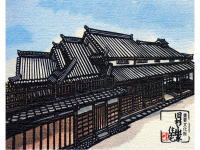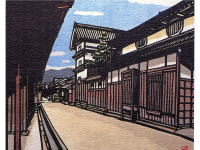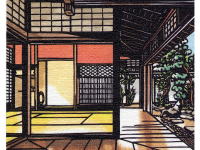富田林寺内町の探訪
I'm glad to intorduce an old town, Jinaimachi, Tondabayashi, Osaka, Japan as a national historic district and heritage site.
It takes 30 minutes from Osaka city to Tondabayashi station by Kintetsu railways. A 10-minutes walk will take you to the historic town.
ギャラリー
welcome to jinaimachi town, tondabayashi, a historic district, japan
| 【Tourist guide to Jinaimachi town, Tondabayashi, a historic district and heritage site of Japan,Tourists attractions part 2/2】 | ||||
| Let's take a walk around the historic district of Tondabayashi Jinaimachi.
Would you enjoy walking from Jinaimachi Visitor Center to the former Sugiyama
residence along Jyounomonsuji street?(in about 90 minutes) This is a quick guide of toursits' attractions. |
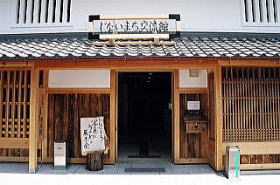 Jinaimachi Visitor Center (Tomiyama-cho) |
|||
| 12. In front of the main gate of Kōushō-ji Betsuin Buddhist temple The temple is a special branch of the headquarters of Koushouji Temple located downtown in Kyoto adjacent to Nishi Honganji Temple. The temple belongs to Jodo Shinshu sect which was called Ikkoushu at the time of its foundation. Shoshuu Shonin, a holy priest, who was engaged in missionary work of Ikkoushu, came to Tondabayashi and built the temple in 1560. Onarimon gate or Chokushimon gate (the gate for the Imperial Envoys) The crest of door panels and the crest of round tiles is the chrysanthemum crest, that is crest of the Imperial Family. Even though the large gate exists next-door, the royal family could not pass through it as built by a samurai warrior Hideyoshi Toyotomi. |
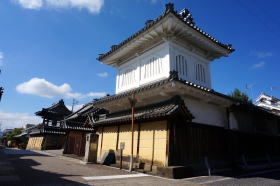 Kōushō-ji Betsuin Buddhist temple |
|||
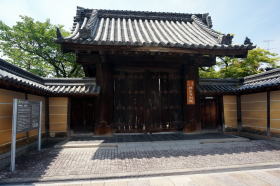 The main gate was said to have been a part of ex. Fushimi Castle |
||||
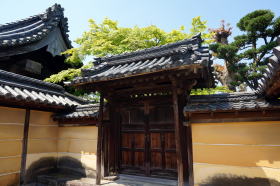 Onarimon gate or Chokushimon gate (the gate for the Imperial Envoys) |
||||
| 13. In the main hall of Koushouji Betsuin Temple Where you are sitting is called Gejin or outer chamber. Everyone sits facing west, and there is a raised stage in the west Buddha have been deified, referred to as Naijin or the chancel. In Buddhism, paradise has been to be in the west. In the center of the raised stage, Buddha Amitabha statue is deified, which is said to be of the Kamakura period. (1185 – 1333) |
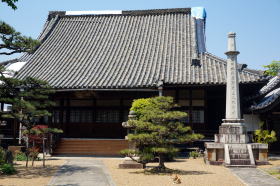 main hall |
|||
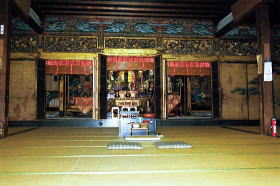 indoors of main hall |
||||
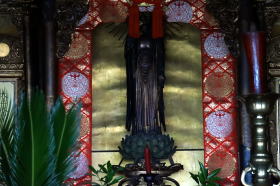 Buddha Amitabha statue is deified |
||||
| In addition, where recessed on the right side of the Amitabha image, the
image of Shinran saint of the founder of the Jodo Shinshu sect. To the left, the image of Honjyaku Shonin, a holy saint, dressed in red robes can be seen, has been enshrined. He belonged to the Hanazono family that leads to the Imperial Family and became the chief priest of the temple. The successors of Hanazono family have still continued to undertake chief priest of the temple. To the left back, Shoshu Shonin, the 16th holy saint of the sect., who founded the branch temple in 1560. |
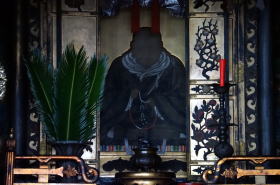 the image of the Shinran saint of the founder of the Jodo Shinshu |
|||
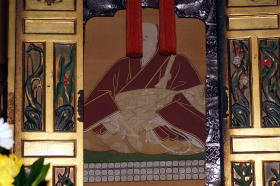 the image of Shoshu Shonin, the 16th holy saint of the sect |
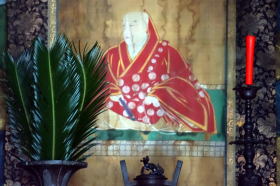 the image of Honjyaku Shonin, a holy saint, dressed in red robes can be seen |
|||
| On left and right sides of the fusuma or sliding wooden doors in Gejin,
the outer chamber, fine gold paintings are drawn. Mr. Kano Jyuseki Hidenobu, one of the Kano school painters in the Edo period drew sliding door paintings (Fusumae). The painter also drew the pine trees on the fusumae along the “pine tree corridor” in ex. Edo Castle of Tokugawa Shogunate, where a familiar bloodshed incident happened in 1701 known as Chushin-gura that Asano Takuminokami slashed Kira Kouzukenosuke by a sword. As the Edo Castle has no longer existed now, the valuable sliding door paintings can only remember a picture of a pine of the corridor at the time. |
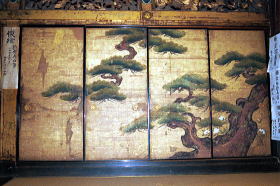 pine tree |
|||
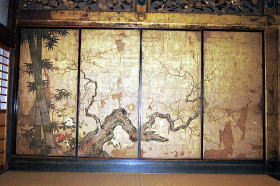 plum tree and bamboo |
||||
| It is assumed that during the Edo period, the main hall was also used as
a place of children education such as writings, mathematics and discipline. |
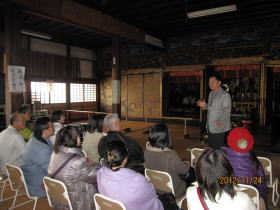 indoors of main hall - outer chamber |
|||
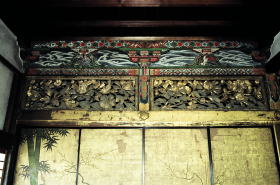 Kaeru-mata |
||||
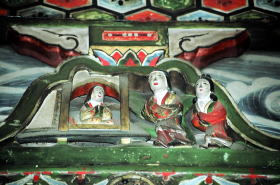 |
||||
| ② The second sculpture from the left end A young woman gives suck o the elderly. This old man is the mother-in-law of the young woman. She is nourishing the mother-in-law as she is no longer able to eat after all her teeth had been completely fell out. |
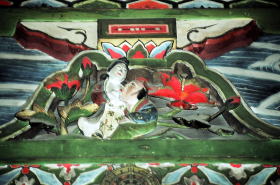 |
|||
| ③ The left end sculpture A son of filial piety is depicted how the bamboo shoots was found in the snow. |
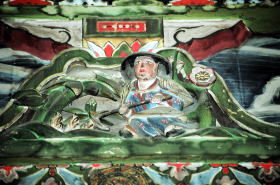 |
|||
| 14. At the intersection of Jyounomon-suji street and Gobo-cho street Looking at the north from here, the landscape is clear for some reason. No telephone poles are seen as utility poles were relocated off the street. The electricity meter device put in the wooden box also contributes to fit the townscape. |
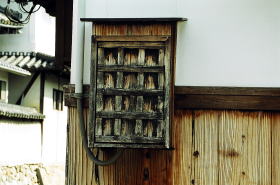 |
|||
| 15. The waterway of the boundary split between Gobo-cho and Hayashi-cho. There exist drainages on both sides of the street. The drainage is called "sewari-suiro”, which literally means "back split waterway". Tondabayashi Jinaimachi is a planned city founded in the Warring States Period and such sewage waterway was originally provided. Rain water, waste water in the home had flown here. This waterway had also become a border of the north side of the house and the south side of the house. Since the premises of two houses had been separated back-to-back by it, it is referred to as a "back split waterway". |
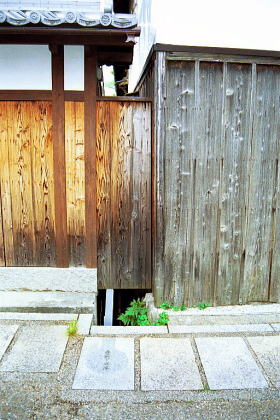 |
|||
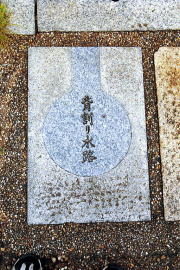 |
||||
|
16. At the corner of the Hashimoto's residence |
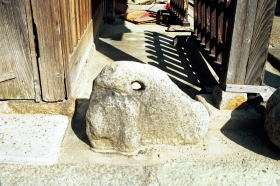 |
|||
| 17. In front of the Nakamura family residence At the time, business license in brewing sake liquor was required. The sake liquor products were carried all the way to Edo. The family undertook the president of local industrial association for sake shipment for Edo. |
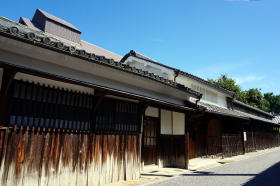 |
|||
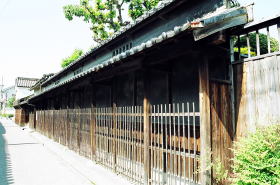 |
||||
|
18. In front of the former Sugiyama's Residence The last head of the family is seen in the photo of signboard. She was a female poet named Tsuyuko Isonokami in the Meiji Era. Her autonym is Ms. Taka(ko) Sugiyama. She was born and grown-up in this house and lived until 1959. After the building lost the head of the family, it was offered for sale to a real estate agent in 1975. When the news appeared, Tondabayashi Municipality purchased at 166 million yen in 1983. It was dismantled, repaired and reconstructed at 230million yen in two-and-a-half years. The city has currently owned and managed the property and it has been open to the public since 1987. It is worthwhile to take a look at it for the admission fee of 400 yen. It has been designated as an important cultural property of the country since 1983. |
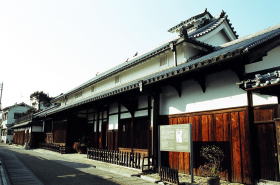 the former Sugiyama's Residence |
|||
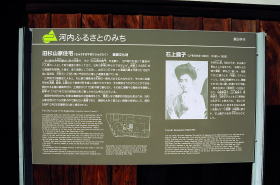 a female poet named Tsuyuko Isonokami in the Meiji Era |
||||
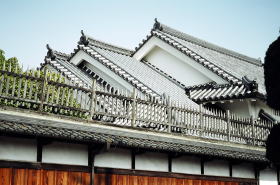 |
||||
| 【Tourist guide to Jinaimachi town, Tondabayashi, a historic district and heritage site of Japan,Tourists attractions part 1/2】 | ||||
|
||||
| |
||||
Information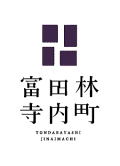
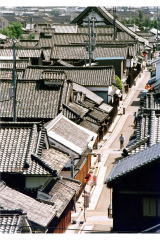
Jinaimachi in Tondabayashi(Jyounomon-suji street)
Photo: provided by Tondabayashi Municipality, unauthorized copying and
replication are strictly prohibited.
National conservation district of valuable traditional buildings
Jinaimachi town, a part of Tondabayashi-cho located in Tonadabayashi city
has been chosen as a national conservation district of valuable traditional
buildings since 1997, which is only selected in Osaka Prefecture. Among
approximately 500 buildings in the town, 181 buildings built during the
period from the Edo era to the early Showa era have been identified as
traditional buildings.
An application for prior approval to the section of cultural properties
in board of education of Tondabayashi city is required when any change
of current exterior appearances viewed from a street in the conservation
district such as enlargement, renovation, repair, redecoration, change
of the color, new construction and demolition of any buildings is to be
made. After repairing works for the conservation of the exterior appearances,
the reconstruction and face-lifting in consideration of landscaping, a
white wall, a board fence, and a lattice door of traditional house remain
as used to be, and rustic and calm atmosphere has been kept as people still
live in those houses.
The signpost is provided with main traditional residences to explain each
origin and history, and those guiding signposts cum street lights have
been placed along the streets of stone-pavement.
In addition, the appearances of newly built buildings are also harmonized
with the neighboring historic district in consideration for the traditional
townscape in Jinaimachi town.
Location
Jinaimachi town, Tondabayashi city, a national historic preservation district
and heritage site of Japan, which is located in the south-eastern part
of Osaka prefecture, the western part of Japan
Directions to Jinaimachi town, Tondabayashi
It is a 10-minute walk from Tondabayashi Staion or the Tondabayashi Nishiguchi Station of Kintetsu Nagano line.
From Kansai International Airport
Airport Limousine Bus service available bound for Kawachi Nagano Station.
(60 minutes) Please take Kintetsu railways from Kawachi Nagano to Tondabayashi.(15
minutes)
From Osaka International Airport (Itami Airport)
Airport Limousine Bus service available bound for Abenobashi Station. (30
minutes) Please take Kintetsu railways from Abenobashi terminal to Tondabayashi.(30 munites)
From JR Shinkasen Shin-Osaka station or
Osaka (Umeda) station
Please take Subway Midousuji line from Shin-Osaka station or Osaka (Umeda)
station to Tennoji Station. (20~30 minutes) Please change trains at Tennoji
and take Kintetsu railways from Abenobashi terminal to Tondabayashi. (30
minutes)
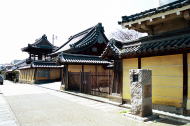
Koushouji Betsuin Temple (Tondabayashi Gobo)
Koushouji Betsuin Temple is a temple of Jodo Shinshu School (Ikkoushuu School),
which became the center of the development and establishment of Jinaimachi
town in Tondabayashi . It has been popular as Mr. Gobo (Tondabayashi Gobo)
among the local residents.
During the Ouei period (1394-1412years) , the
The temple gate looks toward the east and the Jyounomon-suji street. Those buildings such as the bell tower, the drum tower, the main hall,
the reception hall and priest's quarters are set up and arranged.
The main gate has refined style and it became clear in a recent investigation
that the gate was further relocated from Koushouji temple in Kyoto, which
was originally said to be dismantled and reconstructed from one of the
gates at Fushimi castle in Kyoto.
Koushouji Betsuin Temple was designated as an important cultural property
of the country in 2014.
The site-seeing map available in English
Please stop by to the Tourist Information Cetnter or Jinaimachi Visitor Center.
Restrooms
Available at Jinaimachi Visitor Center (Jinaimachi Kouryuukan), Jinaimachi Center and Jinaimachi Tenbou Hiroba (Viewing Terrace)
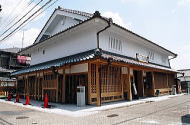
Visitor Center
(Jinaimachi Kouryuukan,
Town Community Center)
Address
9-29, Tondabayashi-cho, Tondabayashi city, Osaka, 584-0033, Japan
TEL.+81-(0)721-26-0110
FAX.+81-(0)721-26-0110
open 10a.m. until 5 p.m.
closed on Monday
Visitor Parking
Road width is very narrow in Jinaimachi town. If traveling by car, please
use Tondabayashi Municipal east parking newly opened in February 2014 (Toll
parking).
You can park the minibus for groups and passenger cars for general use.
Only one parking lot available for minibus, you must book it in advance
with Tondabayashi City Hall. A 15-minute walk to the Jinaimachi Visitor
Center and 5 minute walk up to the former Sugiyama family house, an important
national cultural property.
You will note that you will contact Tondabayashi Municipality Office for
a parking lot of large tourist bus for groups. Thank you in advance for
your kind cooperation.
